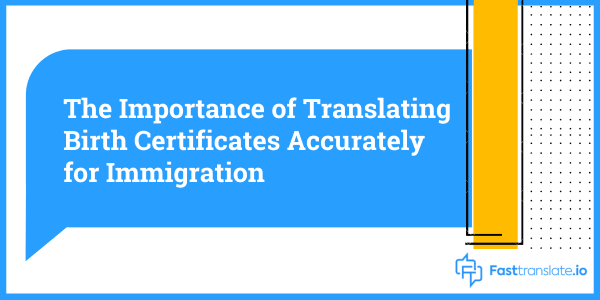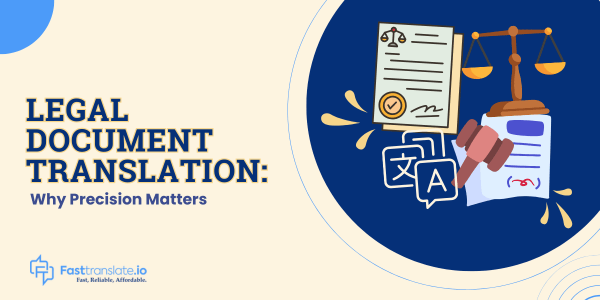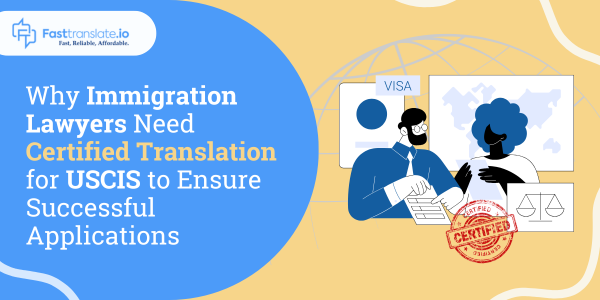Imagine preparing for a new chapter of your life in a different country, only to face unexpected delays due to a minor error in your birth certificate translation. Even a small error in translation can result in significant delays, misunderstandings, or even denial of immigration applications. This article will explain the importance of accurately translating birth certificates for immigration and provide a detailed guide on ensuring precision and reliability in the translation process.
Why Accurate Translation Matters
Legal Requirements
Birth certificates serve as primary documents for verifying identity and familial connections during immigration procedures. Immigration authorities require precise translations to prevent legal complications. Inaccurate translations can result in:
- Delayed Processing: Errors necessitate additional verification, prolonging the application process.
- Document Rejection: Authorities may reject incorrectly translated documents, necessitating re-submission.
- Legal Consequences: Misinterpretations can be seen as attempts to falsify information, leading to potential legal action.
Proving Identity and Relationships
For many immigration applications, such as family reunification or dependent visas, birth certificates are used to establish relationships between applicants. Accurate translation is essential to ensure:
- Correct Identification: Names, dates, and places must be accurately translated to match other official documents.
- Verification of Relationships: Parental and sibling relationships need to be clearly presented and free of errors.
- Consistency Across Documents: All documents must consistently reflect the same information to avoid discrepancies.
Common Challenges in Translating Birth Certificates
Language and Terminology Differences
Translating birth certificates involves overcoming several linguistic challenges:
- Names and Spellings: Variations in spelling and phonetic differences can cause confusion. Translators must ensure names are consistently translated across all documents.
- Date Formats: Different countries use various date formats (e.g., DD/MM/YYYY vs. MM/DD/YYYY), which can lead to misunderstandings if not correctly translated.
- Cultural Terms: Some terms related to family roles and relationships may not have direct equivalents in other languages, requiring careful interpretation.
Handwritten and Old Documents
Many birth certificates are handwritten or come from older records, posing additional difficulties:
- Legibility Issues: Handwriting can be difficult to read, especially if the document is old or damaged.
- Outdated Terminology: Older documents might use archaic terms or spellings that need to be updated accurately in the translation.
Impact of Inaccurate Translations on Immigration
Case Studies of Common Issues
Inaccurate translations can lead to several issues during the immigration process. Here are some common problems:
- Misinterpretation of Names: Variations in name spelling can result in the rejection of documents or requests for further evidence.
- Incorrect Dates: Errors in translating date formats can cause confusion about the applicant’s age or timeline of events.
- Misunderstood Relationships: Incorrect translation of family roles and relationships can lead to questions about the legitimacy of the relationships being claimed.
Real-World Examples
Real-world examples highlight the importance of accurate translations:
- Rejected Applications: There have been cases where applications were rejected due to minor translation errors, leading to significant delays and additional costs.
- Legal Disputes: Inaccurate translations can lead to legal disputes, where applicants have to prove the authenticity of their documents.
Ensuring Accurate Translation
Hiring Professional Translation Services
It is beneficial to use professional translation services to ensure accuracy, especially if you need to translate a birth certificate from French to English or English to Spanish. Advantages include:
- Expertise in Legal and Immigration Terms: Professional translators are well-versed in the specific terminology used in immigration and legal contexts.
- Certified Translations: Many immigration authorities require certified translations, which professional services can provide.
- Quality Assurance: Professional translation services often have multiple levels of review and quality control to catch errors.
Double-Checking Translations
Even with professional services, double-checking translations can help prevent errors. Steps to ensure accuracy include:
- Review by Native Speakers: Having a native speaker review the translation can help identify subtle mistakes.
- Comparing with Originals: Ensuring the translated document matches the original in terms of names, dates, and other critical information.
Best Practices for Accurate Birth Certificate Translation
Choosing the Right Professional Document Translators
When selecting a translation service, consider if they have experience with translating specific language pairs such as English to Spanish, French to English, etc. It is also important to note the following:
- Experience in Immigration Documents: Choose services with proven experience in translating immigration-related documents.
- Certified Translators: Ensure the translators are certified and recognized by relevant immigration authorities.
- Credible Website: Look for professional translators who have a credible website that indicates reliability and professionalism.
Providing Clear Instructions
Clear communication with your translator is key:
- Specific Requirements: Provide specific instructions regarding names, dates, and any particular terminology. Also, indicate any certification or legal requirements such as accredited translation, certification of accuracy, notarization, or apostille.
- Contextual Information: Offer context that may help the translator understand the document better.
Regular Updates and Communication
Maintain regular communication with the translation service to address any issues promptly:
- Progress Updates: Ask for regular updates on how the translation is progressing.
- Immediate Clarifications: Address any questions or concerns from the translator as quickly as possible.
Get Higher Chances of Approval
Accurately translating birth certificates is critical for a successful immigration process. It ensures that all necessary information is correctly conveyed and understood by immigration authorities, preventing delays, rejections, and legal issues. By using professional translation services, double-checking translations, and utilizing translation memory tools, you can achieve precise and reliable translations. Always prioritize accuracy and thoroughness to ensure a smooth immigration journey. Get started on your first translation by clicking our order form.






